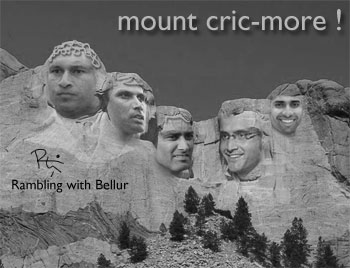Purpose of this post: Stating a closing argument against the malpractice of deriding Murali's achievements in comparison to Warne's.
[statistical closure, I meant - there is no remedy to people using baseless 'arm twisting' tactics of getting away from the statistical argument]
The Test bowling stats of Warne and Murali
The career Tests stats - TAKEN EXCLUDING BANGLADESH AND ZIMBABWE - demonstrate that the two bowlers were statistical twins in geatness stakes, both in terms of their averages & strike rates against various oppositions and also their averages in various lands.
I suspect the Murali baiters will still fish through and come back with one glaring aberration - I am including my closing note on that point at the bottom of this post.
Murali's stats (Tests excluding Zim and Bang):
[Click for LARGER view]
Warnie's stats (Tests excluding Zim and Bang):
[Click for LARGER view]
Dear Murali baiter
I hope you have found out from above career figures
- that both bowlers have consistent and similar bowling averages & strike rates against most teams,
- that England is a common delicacy at (or near) the top in menu for both bowlers
- that both bowlers fare poorly against India (Murali struggled more when touring India, while Warne struggled both home and away).
That was the House of Commons.
Now the BIG DIFFERENCE:
Your favourite point, perhaps: Murali's bowling average falls to an abysmal 75 when he tours Australia (5 tests) while Warne does not have figures anywhere close to those against any team or at any country...
Well are you seriously looking for explanation why that happens to a bowler who is specifically targetted by 30000 strong crowds for heckling in the ground over 5 days, then by the umpires and then by the media including the nation's President?
Let alone bowl, Shane Warne would be unable to turn up in the field during SL tours if the crowd there had gone for his throat by flashing his underwear clad sleazy photos across the grounds and the media. Picking even 12 wickets in 5 matches (Murali's figures in matches played in Australia) would look like matching Laker in such hostile conditions.
Summary:
Even excluding Zim-Bang matches, Murali still scalps better than quarter-to-six wickets per Test @ a bowling avg that is 2% better than Warnie's and a bowling strike rate that is 2% lesser than Warnie's.
Forget the six wickets per Test - it is that big due to Murali getting longer bowling spells with lesser bowlers. Those other two comparative figures tell the story of their amazing equality of greatness in bowling capabilities - within 2% within each other in any which way we look at it.
Should we now close this issue once and for all???
[Stats courtesy: cricinfo]
PS: There is a case for delving further into their stats and finding percentage of top order wickets against each country. But I will leave that exercise to others.



